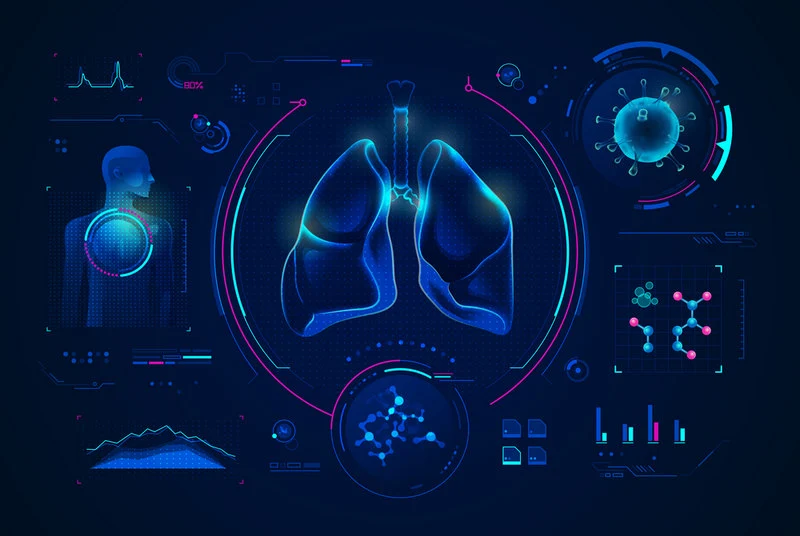Continuous respiration monitoring with the help of a reliable device offers a more proactive...
Continuous respiration monitoring with the help of a reliable device offers a more proactive approach to the early detection of life-threatening conditions and stressors like cardiac episodes, pneumonia, emotional stress, exercise-induced fatigue, cognitive load, physical effort, and many more.
Monitoring your respiration rate helps you identify experiences and activities that strain your respiratory system. Clear identification of such strenuous actions enables you to avoid anything that can overwhelm your system.
With the right tool for respiratory monitoring, you’re in a position to make better lifestyle choices to encourage your general well-being. At the same time, the tool allows you to engage in healthy activities while monitoring your respiratory wellness to ensure you don’t overindulge.
If you’re a wellness enthusiast or have preexisting conditions, read on to find out how a respiration rate tracker can help improve the quality of your life.
What is the respiratory rate?
Respiratory rate, also known as respiratory frequency, is the number of breaths a person takes per minute. The average respiration rate for a healthy adult is 12 to 20 breaths per minute. A respiratory frequency of below 12 or above 25 while resting is abnormal.
Respiratory frequency is one of the vital signs your physician will check during routine checkups. It is an essential indicator of your general health or physical effort during exercise. Conditions that can drastically affect your respiratory rate include pain, anxiety, drug overdose, cardiac arrest, asthma, lung disease, or pneumonia.
A healthy respiratory frequency helps maintain the balance of oxygen and carbon dioxide in your body.
What is respiration monitoring?
Respiration monitoring is a form of medical examination that uses airflow detection and respiratory effort to evaluate sleep-related breathing disorders. Consequently, respiratory monitoring is a crucial part of sleep studies. A doctor will check your brain wave, blood oxygen levels, heart rate, breathing, and eye and leg movements.
Abnormal breathing while asleep affects the quality of your rest and can cause other health problems.
How do respiration monitoring devices work?
There are different types of respiratory monitoring systems. For contact respiration monitoring devices, a medical practitioner will attach part of the monitoring device to your body. Non-contact devices work without contact with your body.
When monitoring respiration, a respiration tracker takes a sample of every exhaled breath to measure and analyze your carbon dioxide level. Respiration trackers have an alarm that notifies you or your physician when they detect abnormal breathing - too slow or too fast.

As technology advances, less bulky and more advanced wearable respiratory sensors are being introduced into the market as a functional solution to respiration monitoring on the go. Wearable respiratory sensors include pressure, acoustic, humidity, oximetry, acceleration, and resistive sensors.
Today, smartwatches are the most common devices fitted with these respiratory monitoring sensors.
What kind of insights can respiration tracking provide?
Respiration tracking is a valuable tool for assessing general well-being. It is common practice for emergency responders and other medical practitioners to track your breathing, especially after a traumatic event.
In respiration tracking, deficits in air exchange and oxygenation in your blood are obvious. Indicators for such deficits are:
- Crackles - crackling beneath the skin indicates air leakage where air passes over the fluid in the smaller airways.
- Rhonchi - an abnormal breathing sound indicating air encountering secretions in your larger airways. Such an encounter hinders normal airflow in your respiratory system. Prolonged periods of air inhibition can cause damage to vital body organs.
- Wheezing - inspiratory and expiratory wheezing indicates air moving in narrowed airways. Narrowed airways can be the result of inflammation from allergic reactions or infections. In inspiratory wheezing, there is a blockage in the upper airway. Expiratory wheezing is common if you’re asthmatic.
What are the benefits of continuous respiratory rate monitoring?
Continuous respiratory rate monitoring has numerous benefits and can help physicians make life-saving decisions. Below are the top three benefits of respiratory rate monitoring.
Preventing severe adverse events
Your respiratory rate is a significant vital sign and a strong indicator of your health. Continuous respiratory rate monitoring can help prevent severe adverse events, especially when you’re on a new medication, trying new food items, or undergoing lifestyle changes.
You can track how your body reacts to different parameters and take measures to ensure survival with regular respiratory monitoring.
Identification of deterioration
In a general ward, physicians monitor your respiratory rate to determine the effectiveness of your treatment. Improvement in your respiratory rate indicates progress. A decline in the same shows deterioration and alerts your doctor for immediate intervention.
Accuracy and effectiveness
Doctors and nurses can use the latest devices to track your respiratory rate more accurately and effectively than during intermittent monitoring. With reliable continuous monitoring of respiration rate, they identify all relevant trends that can help their decision-making to ensure a safe and quick recovery.
What features should you look for in a respiration monitoring device?
Many portable respiration monitoring devices have multiple advanced features. However, they can be expensive, which doesn’t always mean they’re more effective. If you’re in the market for a wearable respiration monitor, below are factors to consider before purchasing.
Wearable
If your respiration monitoring device is wearable, you can take it wherever you go for 24/7 monitoring. An excellent example of a wearable respiration monitor is the Fitbit. Fortunately, wearable respiration monitors have mastered how to blend style and functionality in a practical device.
Wireless
Being wireless is an essential feature for a respiration monitoring device. When a device is wireless, it can connect to the internet or Bluetooth and communicate with different devices like phones and computers to send tracking information. A wireless device also allows use as you go about your daily activities.
Accurate
Your respiration monitoring device should provide accurate real-time readings for maximum effect. Accuracy helps you keep track of your daily habits and gives a fair warning when you overindulge or endanger your health.

Affordable
The best respiration monitoring devices should be affordable. Affordability means getting an accurate and feature-packed respiratory monitor without breaking the bank.
Easy to use
While manufacturers provide tutorials and include user manuals in device packages, your respiration monitoring system should be easy to use. The information should be straightforward to follow without further research or help during setup.
Final Thoughts
On-the-go respiratory monitoring might be pretty new, but it has significant advantages. Thanks to these functional yet stylish devices, you can track your respiration to determine how best you can stay in shape and improve your overall well-being.
While many people leave respiratory monitoring for regular hospital visits, keeping tabs on your respiratory rate should be a regular practice for everyone. Therefore, respiration monitors should be worn by anyone who wants to keep an eye on their respiration rate and patterns. Most importantly, if you’re concerned about respiratory failure but prefer a less bulky monitor, you’re better off investing in a portable one.